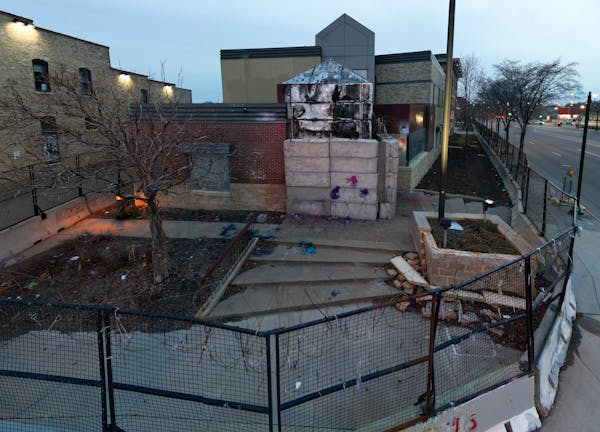A broad coalition of south Minneapolis neighborhood organizations on Tuesday condemned the city's community engagement process on the future site of the Third Precinct, accusing leaders of attempting to ram through a predetermined decision without conducting proper outreach.
From the City Hall rotunda, a group of longtime residents and several small-business owners demanded that city officials restart the process in a more thoughtful and transparent fashion.
"We cannot consent to a decision for which we've had no context or background, as we have no opportunity to genuinely understand the implications of our decisions on our present and future," said Henry Slocum of the Hub Bike Co-op on Minnehaha Avenue. "Why the rush now after years of silence?"
The dilapidated precinct's charred remains have sat vacant at Lake and Minnehaha avenues in south Minneapolis since the police murder of George Floyd and the ensuing civil unrest of 2020.
Last month — after nearly three years of inaction — the city offered residents a choice: renovate the existing structure for an estimated $12 million or construct a new headquarters four blocks away at a city-owned lot for roughly twice the price. Hundreds attended a series of listening sessions to weigh in on the proposal, which many criticized as a "false choice."
The decision surprised organizers with the Longfellow Community Council (LCC), a local neighborhood group contracted by the city to host community dialogues gathering public input about the future of the site in what was originally slated to be a yearlong process. But the timeline and scope quickly changed, forcing them to provide feedback within a matter of weeks.
"It turned into an either/or and not an open conversation," said LCC executive director Rachel Boeke. She lamented that her organization had only 13 days from when the city's webpage went live to promote the five listening sessions to neighbors — an expedited timeline that indicated the city was "opposed to the concept of real engagement."
In those meetings, interim City Operations Officer Heather Johnston repeatedly told citizens that officials researched 28 potential sites within the precinct's geographic boundaries, but found only two that best met their criteria for space, zoning and accessibility. Yet, neighborhood organizers were never privy to that list or details on how it was narrowed down, which they say only deepened mistrust.
Council Member Robin Wonsley, who campaigned in 2021 against reusing the building as a police station, has emerged as the most vocal critic of Mayor Jacob Frey's administration's handling of the engagement process.
On Tuesday, she stood alongside residents to decry what she views as an attempt by city officials to manufacture consent rather than rectify the harm caused by Minneapolis police.
"I saw residents break down in tears repeatedly, as they were prompted to relive one of the most dramatic moments in their lives, in the city's history," she said, recalling the listening sessions. "And then they were proceeded to be asked: 'Would you prefer being punched in your face or your stomach?' "
In response to the news conference, a city spokesman released a statement reiterating their position that Third Precinct officers need to operate out of a building within the boundaries of their precinct because continuing to commute from an office space downtown "makes public safety service delivery inefficient."
"The City is making an intentional effort to hear from the people who live in, work in and visit the precinct area on where they would like to have a new precinct building," the statement read. "To ensure we reached a wider group of people, eight additional in-language conversations were hosted with cultural and under-represented communities for input in the process."
Last year, just before the second anniversary of Floyd's death, the Longfellow Community Council stepped in to solicit feedback on the future of the torched precinct.
Although only a few hundred people participated, 75% said the building should not be reopened as a police station. Instead, residents suggested a variety of alternative uses, like a memorial garden, youth center or museum.
This year the neighborhood group partnered with DeYoung Consulting to distribute a comprehensive survey gathering input on the two proposed Third Precinct sites on behalf of the city. Those results are expected to be presented to the City Council in June, though a timetable on a formal decision remains unclear.
Council Member Andrew Johnson, whose Twelfth Ward includes swaths of the precinct, believes the city should take a step back to examine whether such a large precinct — serving roughly 140,000 people — should continue to staff at such a scale or operate multiple decentralized substations.
Johnson said it's disappointing that, after three years of "radio silence," the city conducted a process that felt inauthentic to residents and distributed a survey that didn't capture the full spectrum of opinions.
"There wasn't even a way to say 'I don't like either of those' [options,]" he said. "So how are we, the City Council, supposed to utilize that data if it's so flawed?"
Staff writer Dave Orrick contributed to this report.

Want to share info with the Star Tribune? How to do it securely

'Safe recovery sites' would offer syringes, naloxone and more to people using drugs. The plan could be in peril.
New Minnesota GOP leaders seek peace with party's anti-establishment wing

Who is Republican Lisa Demuth, Minnesota's first House speaker of color?

